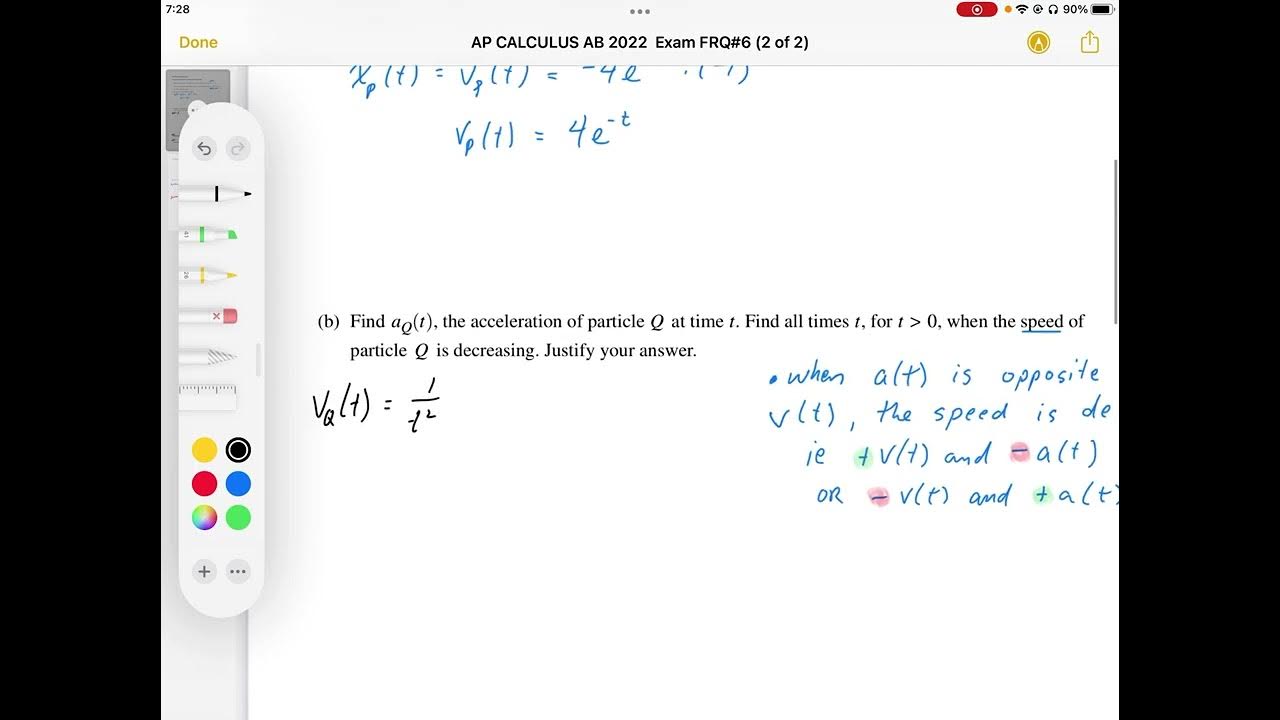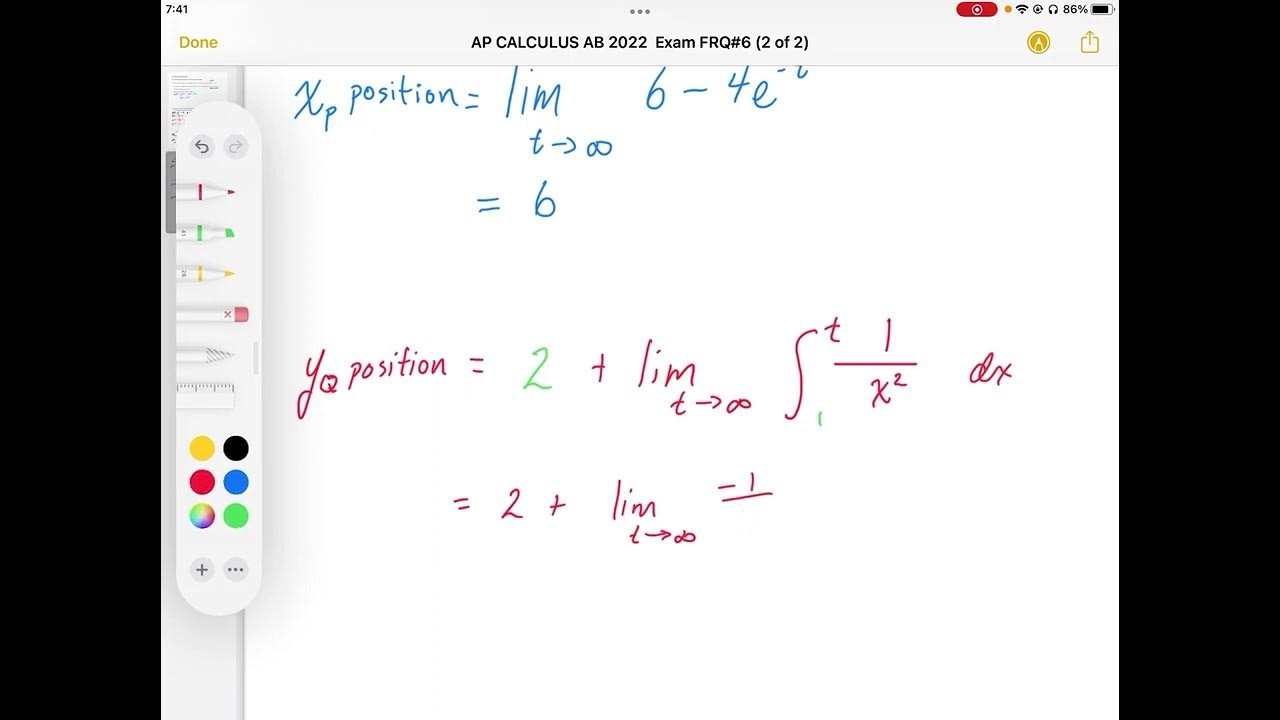AP CALCULUS AB 2022 Exam Full Solution FRQ#6c
TLDRThe transcript discusses finding the position of particle Q at time t, starting with an initial position of y equals 2. It outlines the process of calculating the displacement using the area under the velocity function from 1 to T. The integral of the velocity function is computed, resulting in the expression for yq(t) as 3 minus 1 over T. This expression represents the position of particle Q at time t.
Takeaways
- 📌 The task is to find the position \( y_q(t) \) of particle Q at time \( t \).
- ⏱ The starting point is given as \( y_q(1) = 2 \).
- 📏 Displacement is calculated as the area under the velocity function from time 1 to \( T \).
- 🛠️ The velocity function \( V_Q(x) \) is \( \frac{1}{x^2} \).
- 🔄 To avoid variable conflict, the variable \( X \) is used instead of \( T \) in the integral.
- 🧮 The integral to calculate the displacement is \( \int_{1}^{T} \frac{1}{X^2} dX \).
- 🔢 The antiderivative of \( \frac{1}{X^2} \) is \( -\frac{1}{X} \).
- 📐 Evaluating the definite integral from 1 to \( T \) yields \( -\frac{1}{T} + 1 \).
- 🔄 The final expression for \( y_q(t) \) is \( 2 + (-\frac{1}{T} + 1) \).
- 🧷 Simplifying the expression gives \( y_q(t) = 3 - \frac{1}{T} \).
- 📈 This function \( y_q(t) \) calculates the position of particle Q at any given time \( t \).
Q & A
What is the initial position of particle Q at time t=1?
-The initial position of particle Q at time t=1 is given as y cubed one (y^3(1)) which is equal to 2.
What is the general approach to find the position of a particle at a given time?
-The general approach to find the position of a particle at a given time involves starting from an initial position and then calculating the displacement, which is the area under the velocity function over the time interval.
Why is the variable X used instead of T in the integral?
-The variable X is used instead of T in the integral to avoid conflict with the T variable that represents time in the context of the problem.
What is the velocity function VQ(x) mentioned in the transcript?
-The velocity function VQ(x) is given as 1 over x squared (1/x^2).
How is the displacement calculated in this context?
-The displacement is calculated by integrating the velocity function over the time interval from 1 to T, which is represented as the area under the graph of the function VQ(x) from 1 to T.
What is the antiderivative of the function 1/x^2?
-The antiderivative of the function 1/x^2 is -1/x.
What are the bounds of the integral when calculating the position of particle Q at time T?
-The bounds of the integral are from 1 to T, representing the time interval over which the displacement is calculated.
How does the final expression for y^3(T) simplify after evaluating the integral?
-After evaluating the integral with the bounds from 1 to T, the final expression for y^3(T) simplifies to 3 - 1/T, which represents the position of particle Q at time T.
What is the significance of the negative sign in the antiderivative function?
-The negative sign in the antiderivative function (-1/x) indicates that as x increases, the value of the function decreases, which is a property of the antiderivative of 1/x^2.
What does the expression 3 - 1/T represent in the context of the problem?
-The expression 3 - 1/T represents the final calculated position of particle Q at any given time T, taking into account its initial position and the displacement due to its velocity function.
How does the position of particle Q change as time T increases?
-As time T increases, the term -1/T in the expression for the position of particle Q becomes smaller in magnitude, which means the position of particle Q approaches the value of 3.
What is the physical interpretation of the integral in this context?
-In this context, the integral represents the total distance traveled by particle Q from time t=1 to time T, which is used to calculate its final position.
Outlines
🔢 Calculating Position of Particle Q over Time
The first paragraph explains the process of determining the position of particle Q, denoted as yq(t), at a given time t. The starting point is given as yq(1) = 2. To find the position at any time t, one needs to calculate the displacement, which is equivalent to the area under the velocity function from time 1 to t. The velocity function VQ(x) is specified as 1/x^2, and the integral of this function from 1 to t is used to find the displacement. After integrating, the position yq(t) is found to be 3 - 1/t, which is the final expression for the position of particle Q at time t.
Mindmap
Keywords
💡position
💡particle Q
💡time t
💡starting point
💡displacement
💡velocity function
💡area under the graph
💡anti-differentiate
💡definite integral
💡bounds
💡1 over x squared function
💡simplifying expression
Highlights
The task is to find the position of particle Q at time t, denoted as yq of T.
A starting point is given as yq of 1 equals 2.
Displacement on yq is determined by the area under the velocity function from 1 to T.
The variable X is used instead of T to avoid confusion with the time variable T.
The velocity function VQ of X is given as 1 over X squared.
The position yq of T is calculated by starting at y equals 2 and adding the displacement.
The integral of the velocity function is solved to find the displacement.
The antiderivative of 1 over X squared is found to be negative 1 over X.
The definite integral is evaluated from the bounds of 1 to T.
The resulting expression for yq of T is 2 plus negative 1 over T minus negative 1 over 1.
Simplifying the expression results in yq of T being 3 minus 1 over T.
The final function for the position of particle Q at time t is derived.
The process involves identifying a starting point, calculating displacement, and integrating the velocity function.
The use of variable X is a strategic choice to prevent confusion with the time variable T.
The integral calculation is a key step in determining the position of the particle at time T.
The antiderivative function is crucial for finding the displacement under the velocity graph.
The bounds of integration from 1 to T are essential for the accurate calculation of displacement.
The expression simplification is an important step in obtaining the final function for yq of T.
The final derived function provides a method to calculate the position of particle Q at any given time t.
Transcripts
Browse More Related Video

2022 AP Calculus AB Free Response #6

AP CALCULUS AB 2022 Exam Full Solution FRQ#6(a,b)

2012 AP Calculus AB Free Response #6

Worked example: Motion problems with derivatives | AP Calculus AB | Khan Academy

AP CALCULUS AB 2022 Exam Full Solution FRQ#6d

Average acceleration over interval | AP Calculus BC | Khan Academy
5.0 / 5 (0 votes)
Thanks for rating: